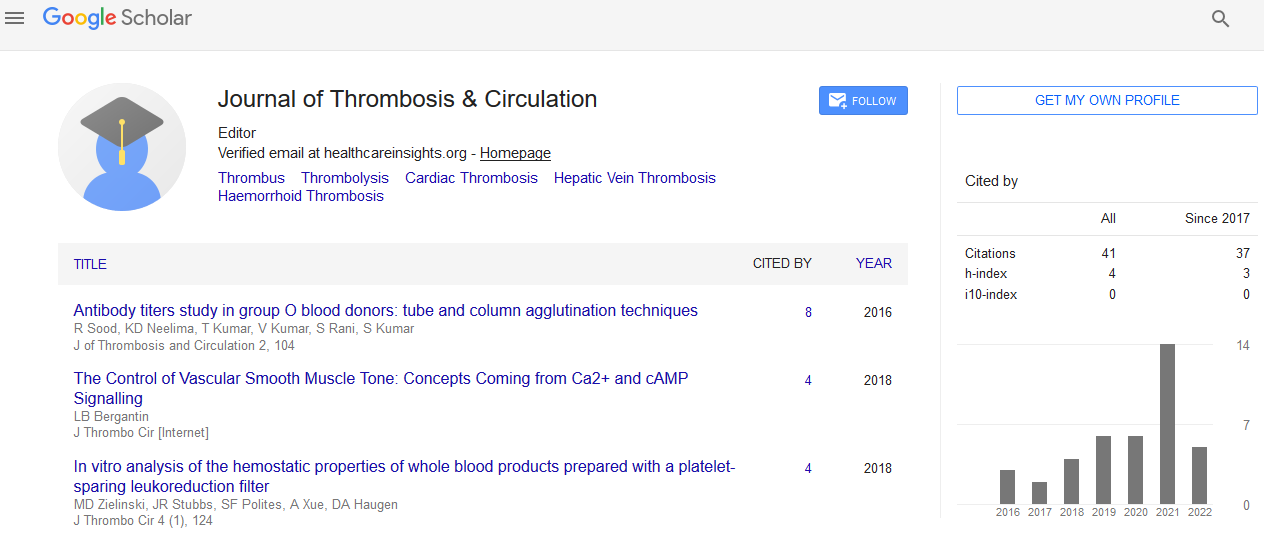Indexed In
- RefSeek
- Hamdard University
- EBSCO A-Z
- Publons
- Google Scholar
Useful Links
Share This Page
Journal Flyer

Open Access Journals
- Agri and Aquaculture
- Biochemistry
- Bioinformatics & Systems Biology
- Business & Management
- Chemistry
- Clinical Sciences
- Engineering
- Food & Nutrition
- General Science
- Genetics & Molecular Biology
- Immunology & Microbiology
- Medical Sciences
- Neuroscience & Psychology
- Nursing & Health Care
- Pharmaceutical Sciences
Abstract
Switch To Heparin and Risk of Bleeding In Patients on Apixaban Undergoing Cardiac Rhythm Procedures: The Amper Af Study
Walid Amara, Rodrigue Garcia, Jerome Taieb, Estelle Gandjbackh, Antoine Dompnier, Saida Cheggour, Frederic Georger, Antoine Milhem and Jacques Mansourati
Aim: This study aimed to describe clinical characteristics and real-life management of patients undergoing cardiac rhythm procedures and therapies while receiving apixaban. Methods: This observational, multicentre study prospectively collected data from patients with non valvular atrial fibrillation (AF) undergoing cardiac rhythm procedures (ablation, pacemaker/ cardioverter defibrillator (ICD) implantation, cardioversion) while receiving apixaban. Patients were followed for up to 30 (±5) days post-procedure. Complications occurring within the 30 days after the procedure were collected. Results: A total of 959 patients were enrolled at 25 centres (September 2015–September 2017). Of these, 115 (12.0%) patients underwent a pacemaker or ICD implantation, 359 (37.4%) AF ablation, 265 (27.6%) flutter ablation and 220 (22.9%) electrical cardioversion. Management of apixaban in the per procedural period was left to investigators’ preference. Early complications included 18 bleeding events (1 tamponade requiring drainage, 2 pericardial effusions without drainage, 11 non-major bleedings for catheter ablation, 4 for pacemaker/ICD implantation). The number of patients bridging from apixaban to heparin/low-molecular-weight heparin (LMWH) was higher for ablation than for the other procedures (51.2% for ablation vs 11.5% and 2.6% for patients undergoing pacemaker/ICD implantation and cardioversion, respectively; P<0.001); the median duration of bridging for all procedures was 24 hours. Comparing patients with and without bleeding events revealed a higher rate of heparin/LMWH bridging in patients with bleeding events (60% vs 35.9%; P=0.03). Conclusion: Periprocedural bridge from Apixaban to Heparin/LMWH during cardiac rhythm procedures is associated with an increased rate of bleeding events at 30 days. Among 959 patients with nonvalvular atrial fibrillation undergoing cardiac rhythm procedures while receiving apixaban, bridging to heparin/low-molecular-weight heparin was more common with ablation than with pacemaker/ICD implantation or cardioversion (51.2% vs 11.5% and 2.6%, respectively; P<0.001), and was associated with a risk of bleeding events (P=0.03). This observational, multicentre study provides important real-life data regarding the management of anticoagulation therapy in patients with nonvalvular atrial fibrillation undergoing cardiac rhythm procedures while receiving apixaban. • Among 959 patients treated at 25 French centres from September 2015 to September 2017 and followed for up to 30 (±5) days post-procedure, bridging to heparin/low-molecular-weight heparin was more common with ablation than with pacemaker/ICD implantation or cardioversion (51.2% vs 11.5% and 2.6%, respectively; P<0.001). • The median duration of bridging was 24 hours for all procedures, and switching was associated with an increased risk of bleeding events (P=0.03).
Published Date: 2020-09-23; Received Date: 2020-07-20

